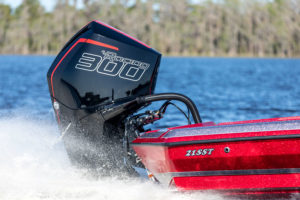 Mercury Racing’s new 4.6L V-8 250R and 300R FourStroke outboards are equipped with Adaptive Speed Control (ASC). This Mercury-exclusive feature allows boaters to maintain engine speed (rpm) regardless of load or condition changes – such as rough water, tight turns, tow sports and lower speeds on plane – without having to frequently adjust throttle position, a first for the outboard industry.
Mercury Racing’s new 4.6L V-8 250R and 300R FourStroke outboards are equipped with Adaptive Speed Control (ASC). This Mercury-exclusive feature allows boaters to maintain engine speed (rpm) regardless of load or condition changes – such as rough water, tight turns, tow sports and lower speeds on plane – without having to frequently adjust throttle position, a first for the outboard industry.
You may be wondering how this technology works and how to “dial in” your boat to take full advantage of the improved throttle response and “sportier” feel it provides.
While the system is designed to be intuitive to operate, understanding boat setup and operation with and without ASC will help maximize performance when changing the setup or when running the engine to its limits.
Boating Without Adaptive Speed Control
To get a boat up on plane without Adaptive Speed Control, push the throttle full forward, pulling back once on plane. Trim the engine to lift the hull, reduce drag, and increase engine rpm even with constant throttle. Heavy boats require more throttle to reach the same rpm as a lightly loaded boat.
Prop selection for this scenario is relatively straightforward. Too little pitch will result in engine revving past its recommended rpm operating range. Too much pitch will limit the engine from reaching its peak rpm for maximum speed.
250R & 300R FourStrokes
With Mercury Racing’s new V-8 FourStroke outboards, Adaptive Speed Control constantly adjusts the engine throttle and available airflow to achieve or maintain a given rpm. When the boat’s load curve is within expected limits, getting on plane no longer requires a throttle overshoot or pull-back to maintain speed.
Adjusting trim will still…
CLICK HERE TO CONTINUE READING
This article was originally posted on mercuryracing.com.






